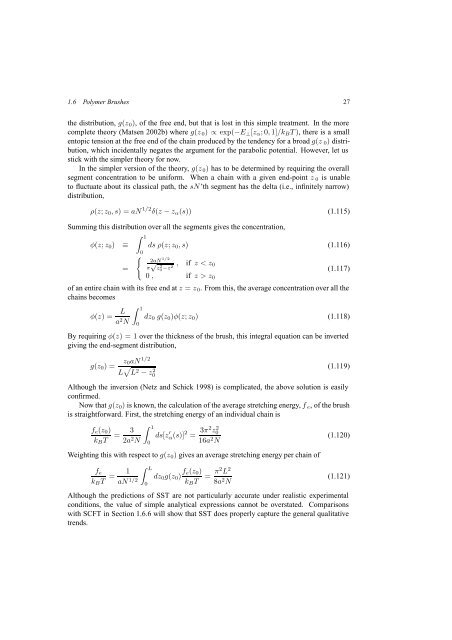Self-Consistent Field Theory and Its Applications by M. W. Matsen
Self-Consistent Field Theory and Its Applications by M. W. Matsen
Self-Consistent Field Theory and Its Applications by M. W. Matsen
Create successful ePaper yourself
Turn your PDF publications into a flip-book with our unique Google optimized e-Paper software.
1.6 Polymer Brushes 27<br />
the distribution, g(z 0 ), of the free end, but that is lost in this simple treatment. In the more<br />
complete theory (<strong>Matsen</strong> 2002b) where g(z 0 ) ∝ exp(−E ⊥ [z α ;0, 1]/k B T ), there is a small<br />
entopic tension at the free end of the chain produced <strong>by</strong> the tendency for a broad g(z 0 ) distribution,<br />
which incidentally negates the argument for the parabolic potential. However, let us<br />
stick with the simpler theory for now.<br />
In the simpler version of the theory, g(z 0 ) has to be determined <strong>by</strong> requiring the overall<br />
segment concentration to be uniform. When a chain with a given end-point z 0 is unable<br />
to fluctuate about its classical path, the sN’th segment has the delta (i.e., infinitely narrow)<br />
distribution,<br />
ρ(z; z 0 ,s)=aN 1/2 δ(z − z α (s)) (1.115)<br />
Summing this distribution over all the segments gives the concentration,<br />
φ(z; z 0 )<br />
≡<br />
∫ 1<br />
ds ρ(z; z 0 ,s) (1.116)<br />
0<br />
{<br />
2aN<br />
1/2<br />
=<br />
√ , if zz 0<br />
of an entire chain with its free end at z = z 0 . From this, the average concentration over all the<br />
chains becomes<br />
∫ 1<br />
φ(z) =<br />
L<br />
a 2 dz 0 g(z 0 )φ(z; z 0 ) (1.118)<br />
N 0<br />
By requiring φ(z) =1over the thickness of the brush, this integral equation can be inverted<br />
giving the end-segment distribution,<br />
g(z 0 )= z 0aN 1/2<br />
L √ L 2 − z 2 0<br />
(1.119)<br />
Although the inversion (Netz <strong>and</strong> Schick 1998) is complicated, the above solution is easily<br />
confirmed.<br />
Now that g(z 0 ) is known, the calculation of the average stretching energy, f e , of the brush<br />
is straightforward. First, the stretching energy of an individual chain is<br />
f e (z 0 )<br />
k B T = 3<br />
2a 2 N<br />
∫ 1<br />
0<br />
ds[z ′ α(s)] 2 = 3π2 z 2 0<br />
16a 2 N<br />
Weighting this with respect to g(z 0 ) gives an average stretching energy per chain of<br />
(1.120)<br />
f e<br />
k B T = 1<br />
aN 1/2 ∫ L<br />
0<br />
dz 0 g(z 0 ) f e(z 0 )<br />
k B T = π2 L 2<br />
8a 2 N<br />
(1.121)<br />
Although the predictions of SST are not particularly accurate under realistic experimental<br />
conditions, the value of simple analytical expressions cannot be overstated. Comparisons<br />
with SCFT in Section 1.6.6 will show that SST does properly capture the general qualitative<br />
trends.
















